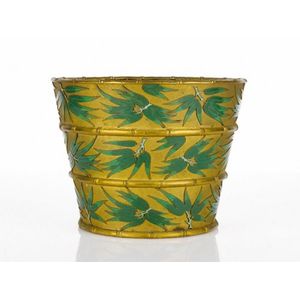Emerald Green Art Deco Glass Vase by Josef Inwald
You must be a subscriber, and be logged in to view price and dealer details.
Subscribe Now to view actual auction price for this item
When you subscribe, you have the option of setting the currency in which to display prices to $Au, $US, $NZ or Stg.
- Art Deco Period - The Art Deco period was a cultural movement that emerged in the 1920s and 1930s, and was characterized by its emphasis on modernism, luxury, and elegance. The name "Art Deco" comes from the Exposition Internationale des Arts Décoratifs et Industriels Modernes, a large exhibition held in Paris in 1925 that showcased the latest trends in decorative arts.
Art Deco was a reaction against the ornate and elaborate styles of the previous era, and reflected a new modern sensibility. It was characterized by streamlined, geometric shapes, bright colours, and the use of new materials such as chrome, glass, and Bakelite. Art Deco designers sought to create a sense of luxury and sophistication, often incorporating expensive materials such as ivory, marble, and rare woods.
Art Deco had a significant impact on a wide range of artistic fields, including architecture, fashion, graphic design, and interior design. Some of the most iconic examples of Art Deco architecture include the Empire State Building in New York City, the Hoover Building in London, and the Palais de Chaillot in Paris.
The Art Deco period came to an end in the 1940s, as World War II and changing cultural trends led to a shift in artistic styles. However, Art Deco remains an important influence on design and art, and continues to be celebrated for its modernist sensibility and glamorous aesthetic. - Attributed - A cataloguing term where the item in the opinion of the cataloguers, is a of the period of the artist, craftsman or designer, and which probably in whole or part is the work of that person.
- Emeralds - Emeralds have been used in jewellery making for thousands of years, and are prized for their deep green colour, which is caused by the presence of chromium and vanadium in the mineral beryl. Because of their rare colour, emeralds are often more valuable than diamonds of a similar size and quality. In jewellery making, emeralds are typically cut into round or oval shapes to maximize their color and clarity. They are often set in gold or platinum and used as the centrepiece of a piece of jewellery, such as a ring or necklace. They can also be used in combination with other gems, such as diamonds, to create intricate and beautiful designs.
This item has been included into following indexes:
Visually similar items

A Rene Lalique Coq Et Plumes vase, designed 1928, the tapering cylindrical body moulded to the lower section with cockerels gathered amongst reeds, in frosted and clear glass with a blue patina, acid etched R. Lalique France, 15.5 cm high. Provenance: Mr H

Rene Lalique Laurier vase clear. Frosted & opalescent, the cylindrical form vase rising to a slightly everted rim, the body moulded with leaves & berries, design number 947. Signed R Lalique'. Condition fair, chip to the base. Height 17.5 cm

A Lalique Narcisse vase, post-1945 production, the flared cylindrical body with a brushed finish, moulded with a wrythen pattern, inscribed Lalique France, 26.5 cm high. Provenance: Mr Hans Mueller and Mrs Gertrud Mueller, Sydney.

Champleve enamelled and brass jardiniere, with bamboo border encircling body and green enamelled leaves. Height 16 cm. Diameter 20 cm
